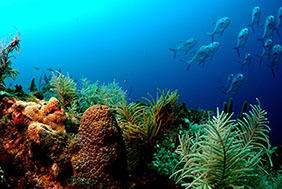-
Home
-
Data & Publications
-
Regional Portals
- About Regional Portals
- Florida
- Navassa Island
- Puerto Rico
- Flower Garden Banks
- U.S. Virgin Islands
- American Samoa
- Commonwealth of the Northern Mariana Islands
- Federated States of Micronesia
- Guam
- Main Hawaiian Islands
- Republic of the Marshall Islands
- Northwestern Hawaiian Islands
- Republic of Palau
- Pacific Remote Island Areas
-
CRCP Activities
- Glossary
Predicting extreme tide events to inform shallow reef community restoration and management in Guam

Guam's shallow back reef and reef flat environments provide important fish habitats critical to the island's ecology and economy. Shallow coral reef communities have precipitously declined in recent years (2013-2017) due to annual mass mortality events. A combination of ocean warming-induced bleaching and El Niņo-Southern Oscillation (ENSO)-related extreme low-stand tide events caused significant mortality in species of staghorn Acropora and other dominant coral genera (Porites, Pocillopora, and Pavona) associated with staghorn habitats. 2013 brought the most extensive regional mass bleaching event ever recorded, affecting 85% of species in Guam and the Commonwealth of the Northern Mariana Islands (CNMI). This was followed by another bleaching event that began six months later, principally affecting shallow staghorn populations. ENSO-related extreme low-stand tide events occurred in 2015, extending through the year and causing shallow reef communities to be subaerially exposed for several afternoon hours on successive days each month (see photograph). These combined events resulted in the loss of 53% of staghorn populations over this three-year period. These events were immediately followed by a further two consecutive years of heat stress and associated bleaching.

This project report describes a novel approach to develop a spatially explicit model to predict the frequency of low-stand events. This will help guide the selection of restoration sites, and identify both sites at future risk and those with greater refuge from low-stand events that could benefit from increased management. Benthic surveys to evaluate mortality were undertaken at 18 sites around Guam that experienced significant coral mortality from recent extreme low-tide events or were strategically selected for geographic representation around the island. At these sites, tidal variations were logged over five-week periods, and critical depth thresholds (e.g., past subaerial exposure) were determined. The tidal data from the sites were correlated with long-term data from the Apra Harbor tide gauge on Guam. Using the derived relationships and depth thresholds, and modifying a model used to predict high-tide (or nuisance) events, spatially-explicit predictions of vulnerability to subaerial exposure were produced (see map). This analysis has demonstrated the applicability of the methodology to other sites in the Pacific region, such as American Samoa and the Saipan Lagoon in CNMI, each of which has experienced similar, significant, recent coral loss.

Climate change is creating a new environmental paradigm wherein sessile benthic communities must either adjust (acclimate and adapt) to new regimes of sea surface temperature, seasonality, and extreme event frequency, duration and severity - or become extirpated or extinct. How species and populations respond to these events, their genetically-based ability to acclimate and adapt, and the role of local environmental variability in their acclimatization are topics of current local and global research focus. Such information is critical to the formulation of adaptive management and restoration strategies.
Resources:
The report appendix consists of one-page summaries for each of the 18 studied sites, for use in communication (e.g., with policy makers, general public) and to inform local management response.
Acknowledgements:
Financial support for this applied research was provided by the NOAA Coral Reef Conservation Program; the University of Guam Marine Laboratory; and NOAA grant NA14NES4320003 (Cooperative Institute for Climate and Satellites - CICS) at the University of Maryland/ESSIC.
Citation:
Heron, S.F., Raymundo, L., Sweet, W.V., Papa, A., Moreland-Ochoa, C., Burdick, D.R. 2020. Predicting extreme tide events to inform shallow reef community restoration and management in Guam. NOAA Technical Memorandum CRCP 38 and UoG Marine Laboratory Technical Report 167, 48 pp. https://doi.org/10.25923/bb8f-gf73
For More Information:
Scott Heron (scott.heron@jcu.edu.au), Laurie Raymundo (lraymundo@triton.uog.edu), David Burdick (burdickd@triton.uog.edu)


